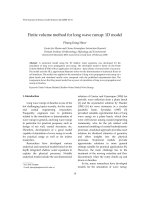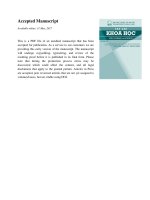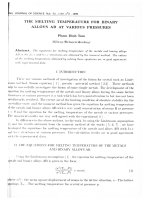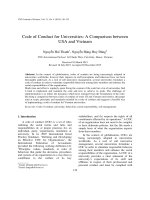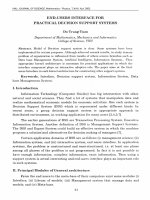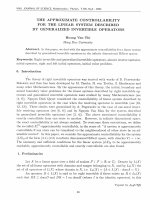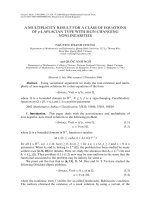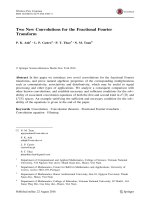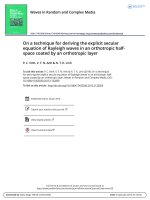DSpace at VNU: Finite volume method for long wave runup: 1D model
Bạn đang xem bản rút gọn của tài liệu. Xem và tải ngay bản đầy đủ của tài liệu tại đây (800 KB, 6 trang )
V N U Jo u rn al of Science, E arth Sciences 24 (2008) 10-15
Finite volume method for long wave runup: 1D model
Phung Dang Hieu*
Centerỷor Marine and Ocean-Atmosphere ỉnteraction Research
Vietnam Institute of Meteorologỵ, Hydrology and Environment
R cceived 20 D ecem ber 2007; receivcd in reviscd form 15 F eb ru ary 2008
A b stract. A n u m erical m odcl using the 1D shallovv vvater e q u a tio n s vvas d evolopcd for the
sim u la tio n o f long vvave p ro p ag atio n and ru n u p . The d ev c lo p e d m odel is b a sc d on thc Finite
V olum c M cth o d (FVM ) vvith an application oí G o d unov - ty p e sch e m e of socond o rd e r of accuracy.
T he m odel u s e s th e HLL ap p ro x im a te R iem ann solver for th e d e te rm in a tio n of n u m erical íluxcs at
cell in teríaccs. T h e m odel w as ap p lied to th c sim ulation of long w a v c p ro p a g atio n a n d ru n u p on a
p lan e beach a n d sim u la tc d results w ere com pared w ith the p u b lish c d cx p erim en tal data. The
co m p ariso n sh o w s th a t th e p re sen t m odel has a povver of sim u la tio n o f long vvave p ro p a g atio n a n d
ru n u p o n b eachcs.
Keỵivords: P inite V oỉum e M ethod; Shallovv W ater M odel; YVavc R unup.
1. In tro d u ctio n
analytical resuits include tho one-dim ensional
solution of C arrier and G reenspan (1958) for
periodic vvave reílection from a plane beach
[1] and the asym m etric solution by Thacker
(1981) [6] for vvave resonance in a circular
parabolic
basin.
Synolakis
(1987)
[5]
provided valuable experim ental data of long
w ave ru n u p on a plane beach, w hich then
vvere well k now n am ong Coastal engineering
com m unity, w ho do the job related with
num erical m odeling oí Coastal hydrodynam ic
processes. A nalytical approach provides exact
solution for idealized situation of geom etry
and offers insights into the physical
processes.
N um erical
m odels
provide
approxim ate solutions in m ore general
settings suitable for practical applications [9].
Hovvever, the m ain challenge lies in the
treatm ent of the m oving vvaterline and flow
Long w ave ru n u p on beaches is one of tho
hot challenging topics recently, for the ocean
and
Coastal
engineering
researchers.
Frequently, engineers face to problem s
related to the sim u latio n or determ ination of
w ave ru n u p in gcneral, and long vvave runup
in particular for practical purposes, such as
design of sea w all/ Coastal structures, etc.
Thereíore, d ev elo p m en t of a good m odel
capable of sim u latio n of w ave ru n u p is vvorth
for practical u sag e as vvell as for indoor
researches.
Researchers have developed various
analytical and num erical m odels based on the
depth integrated shallovv vvater equations to
explain the physical processes. N otable
discontinuity vvhon the w ater climbs u p and
dovvn on beaches.
* Tel.: 84-4-7733090
E-mail: phungdanghieu@ \'kttv.edu.vn
10
Phung Dang tìieu / VN U Ịounuìl of Science, Earth Sciences 24 (2008) 10-15
So far, m any researchers have dcveloped
m odels for the sim ulation of w ave runup.
Shuto and Goto (1978) [4] used íinite
diííerence m ethod w ith a staggered schem e
and a Lagrangian description of the m oving
shoreline; Liu et al. (1995) m odelcd ru n u p
through ílooding and drying of the cells in
response to adịacent w ater level changes [3].
Titov and Synolakis (1995, 1998) [7, 8]
proposed VTCS-2 m odel using the splitting
technique and characteristic line m ethod. Hu
et al. (2000) [2] developed an 1D m odel using
FVM vvith a G odunov-type u p w in d scheme
to sim ulate the w ave overtopping o í seawall.
VVei el al. (2006) presented a m odcl for long
w ave runup using exact Ricm ann solver [9].
In this study, a num erical m odel is
devclopcd using FVM and the robust
approxim ate Riem ann solver HLL (H arten,
Lax and van Leer) for the sim ulation of long
wave ru n u p on a beach. The m odel is veriíied
for the case of experim ent p roposed by
Synolakis (1987). C om parisons are carried out
between sim ulated results and experim ental
data (Synolakis, 1987) [5]. The details of this
study are given belovv.
2. N um erical m odel
2.1. Governing equation
The present stu d y considers Onedim ensional (1D) depth-integrated Shallovv
w ater equations in the C artesian coordinate
system ( x ,t) . The conservation form of the
1D non-linear shallovv w ater equations is
vvritten as
a u ỔF e
— +— =s
(1)
õt õx
where u is the vector of conserved variables;
F is the ílux vectors; and s is the source term.
The explicit íorm of these vectors is explained
11
as follows:
0
Hu
(2 )
g H -A
& p.
w here g : gravitational acceleration; p : w ater
ư
H iỉ+ ịg rí1
,s =
density; h : still vvater depth; H : total w ater
depth, H = /i + ^ in vvhich Tj(x,t) is the
displacem ent of w ater suríace ÍTom the still
vvater level; Tx : bottom shear stress given by:
Tx =
p C ,u\u\,C f =
g”
(3)
w here n: M anning coefficient for the bed
roughness.
2.2. Numerical scheme
The íinite volum e íorm ulation im poses
conservation laws in a control volume.
Integration of Eq. (1) over a cell vvith the
applieation of the G reen's theorem , gives:
díì+ J.F-ndr=
(4)
w here í ì : cell dom ain; r : b o u n d ary of Q ; n :
norm al outw ard vector of the boundary.
Taking the tim e integration of Eq. (4) over
duration Aí from
to t2, w e have:
r f
r
+jdf
Ị F-nár =r |áíJ^SáQ
(5)
'í
í
C onsidering the case of one-dim ensional
m odel w ith cell size of A x , from Eq. (5) we
can deduce:
—
í ư ( x , / 2> ừ — —
AxAt
i
x<"
[ U (x ,f,V ic
AxAt
v
2
l
x'
v
2
(6)
Ax
1 '» * *
=— — ịdt f Sdx
ố x ầ tỊ
L
' 2
12
Phung Dang Hieu / VNU Ịoumal o f Science, Eữrth Sciences 24 (2008) 10-15
Ax
1 ** 2
N ote that th e integral —-— í u ịx,L )d x
AxAt JAl v 2 r
x'~
2
is exactly the cell averaged value of u at time
t2, divided by A t . The prescnt m odel uscs
uniíorm cells w ith dim ension Ax, thus, the
integrated g o v erning cquations (6) vvith a
tim e step At can be approxim ated vvith a half
tim e step average for the interíace íluxes and
source term to becom e ị :
2
Uí*1 = u ? - ■ £ [ ! ? : / « -I? _ v « ] + A ts r ,,í (7)
w here i is index at thc cell center; k denotes
the current tim e step; the halí indices i + 1 /2
and i - 1 / 2 indicate thc cell interíaces; and
k +1 /2 den o tes the average w ithin a time
step betw een k and k + 1. N otc that, in Eq.
(7) the variables u and source term s are
cell-averaged values (vve use this m eaning
from now on).
To solve th e equation (7), w e necd to
estim ate th cn u m c ric a l íluxes FấVi/22 and F*-V/22
at the interíaccs. In this study, w e use the
G odunov-type schem c íor this purpose.
According to the G odunov-type scheme, the
num erical íluxes at a cell interíace could be
obtained by solving a local Ricm ann problem
at the interíace. The G odunov schem e can be
expressed as:
x / t =0
(8)
w here F( ) rep resen ts the num erical flux at
the cell interíace obtained by solving a local
Riem ann problem using the data Uj;1/2 and
Uf+1/2 on each sid e of the cell interíace. There
are a n u m b er of approxim ate Riemann
solvers p roposed by diíícren t authors, such as
O sher, Roe, etc. In this study, we use the HLL
approxim ate R iem ann solver. The íorm ula for
the solver is given as:
p’ —
"
"
~^ )
(9)
SL = minỊwL - C L ,U “ C #|
(10)
SR = max|MR +CR,U + C ’Ị
(11)
u, +u
u —
= 1 l + (C l - C r )
(12)
Q* -
t(13)
2
w here F* denotes the HLL approxim ate
R iem ann solver; UL and UR are respectively
the d ep th averaged velocities of w ater flow at
left an d right side of the cell interíace; CL and
CR are the shallow w ater vvave speeds at left
and right side oí the interíace.
In this study, vve used three regions of
w ave specd to estim ate the cell interíace
íluxes as follows:
F,
SL z 0
F* if SL < 0 < Sị
(14)
SR <: 0
To get a second order of accuracy for the
num erical model, U ^1/2 and U *l/2/ UL and
UR , CL and CR are interpolated by using a
linear reconstruction m cthod based on the
averaged values at ccll centers vvith the usage
of the TVD-type iim iter, which is the average
of M in-m ode lim itcr and Roe limiter. For the
wet and dry cell treatm ent, we use a
m inim um vvet dcpth, the cell is assum ed to be
dry w hen its vvater depth less than the
m inim um vvet dep th (in this study w e choose
m inim um vvet dep th of 10 5m).
3. S im ulation results and discussion
3.1. Experimental coĩĩditiotĩ
A num erical experim ent is carried out for
the condition sim ilar to the experim ent done
Phung Dang tìieu / VhlU Ịournal of Science, Earth Sciences 24 (2008) 10-15
by Synolakis (1987). In this experim ent, there
vvas a beach having a slope of 1:19.85
connected to a horizo n tal bottom w ith vvater
d ep th of h = lm . The toe of the beach located
at distance x2/h = 19.85 and shoreline vvas at
X
= 0 . A solitary vvave vvith the height of
/ h = 0.3
was generated
13
x }/h = 24.42
at
Corning to the beach from the p art of constant
w ater depth. The experim ent provided vvith
experim ental data of w ater suríace proíile at
different time. Fig. 1 show s the sketch of the
experim ent.
Fig. 1. Sketch of S ynolakis's experim ent.
For the num erical sim ulation, the initial
solitary vvave is sim ulated by the solitary
w ave íorm ula as:
7 (x , 0) = 7 -sech
h
ỈM r
t e (x-
u(x,0) = 7ỹ(x,0)j£
x
•
(15)
(16)
The com putation dom ain is discretized
into cells in a regular m esh with space step
Ax = 0 .1 m an d the sim ulation is carried out
w ith the initial condition given by equations
(15) and (16). Sim ulated results of vvater
suríace proíile are recorded for com paring
w ith the experim ental data.
Fig. 2. Initial free su ríace of th e sim ulatio n .
0
05
04
03
1 02
h 01
0
3.2. Results and discussion
Eỵọ data (Synoialaỉ, 1987)
— Nliti Rssdbt
\ \
1F V
-01
-10
ỉ X
10
15
20
h
Fig. 2 shovvs the initial free suríace
sim ulated by the num erical m odel.
Fig. 3. C o m p ariso n vvith ex p e rim en tal data: n ear
b reak in g location.
Phung Dang Hieu / VNU Ịoumaỉ of Science, Earth Sciences 24 (2008) 10-15
14
0 bp đata {SynoỉalQS. 1987]
— Nm Resits
1 02
/l 01
0
■01
•10
-5
5 *
10
15
20
h
Fig. 4. C o m p ariso n vvith ex p erim cn tal data: ru n u p
p h ase.
0 Ejụ đata(Synoỉatas. 1967)1
05
Ị\
04
03
5
i * Ịị
\
02
h 01
0
0.1
•
1— Njĩ\ResJs
ĨÌ-U
u
■10
. . . . .
-5
. . .
0 000 0^ 0 0^0 coco oa c
\\J o c
. V . Ể L ............- ......................
—»
5
X
10
15
20
h
Fig. 5. C o m p ariso n w ith ex p e rim en tal data: ru n d o w n
phase.
Fig. 3 shovvs the com parison betw een
sim ulated results and experim cntal d ata of
free suríace proíile near the brcaking location.
It is seen that sim ulated results have some
discrepancy at the vvave crest com pared to
the experim ental data. This could be d u e to
the lim itation of the shallovv vvater equation
itselí in sim ulation of vvave dispersion and
breaking. Aíter that, in side the surf zone,
com puted results agree very vvell w ith the
experim ental data, especially during the
ru n u p process on the beach (see Fig. 4 at
norm alized time 25, 35, 45). The highest
ru n u p attains at norm alized time of 45 and
the highest ru n u p is of 0.5m. This result is
about 1.6 tim es of the initial w ave height. The
agrecm ent betvveen sim ulated results and
experim ental data d u rin g the timc of runup
process could be explained as d u e to
conservation of m ass and m om entum
en su red in the present m odel using the
conserved FVM.
For the sim ulation of long vvave ru n u p on
beaches, in practice, the m ost im portant thing
is correctly sim ulated ru n u p process and the
highest climb u p oí vvater íront. A lthough
sim ulating the vvave proíile in the breaking
zonc is not vvell, the present m odel is still
capable of sim ulation of w ave ru n u p process
on the beach, specially the highest ru n u p
could be well sim ulated by the m odel. This is
one of the practical purposes.
A t the stage of ru n d o w n (sce Fig. 5 at the
norm alized time of 55), the vvatcr including
the position of shoreline and inundation
d ep th on the beach is still vvell sim ulated.
Thus, the developed m odel w ith the FVM
proposed in this study has a povver of
expansion to a tvvo-dimensional m odel and is
also capable of sim ulation of non-linear wave
ru n u p , rundow n processes including the
prediction of highest ru n u p of water.
Phung Dang Hieu / VN U Ịoumal of Science, Earth Sciences 24 (2008) 20-15
4. C onclusions
A FVM based num erical m odel has been
successíully developcd for the sim ulation of
long vvave propagation and ru n u p . This
m odel specially well sim ulates the highest
runup of w ater an d inundation d ep th on the
beach during ru n u p and rundovvn processes.
The good
agreem ent betw een the
sim ulated results and experim ental data
reveals that the m odel has a potential for
practical uses and should be stu d ied íurther
in order to expand to a tvvo-dimensional
model íor various purposes in praetice, such
as sim ulation of Tsunam i ru n u p and
inundation on Coastal areas, ílooding d u e to
storm surge, etc.
A cknovvledgem ents
This paper w as com pleted partly under
íinancial su p p o rt of F undam ental Research
Project 304006 íu n d cd by Victnam M inistry of
Science and Technology.
15
R eíerences
[1] G.E. C arrier, H.p. G reen sp an , W atcr vvaves of
íin ite am p litu d c on a slo p in g bcach, Ịournal of
Fluid Mechanics 4 (1958) 97.
[2] K. H u , C.G. M ingham , D.M. C auson, N um crical
sim u latio n of w av c o v o rto p p in g of Coastal
stru c tu re s using th e n o n -lin ear shallo w vvater
equations, Coastal Engineering, Eỉsevier 41 (2000)
433.
[3] P.L-F Liu et al., R u n u p of so litary w a v e on a
circdlar island, Ịoum al o f Fỉuid Mechanics 302
(1995)259.
|4] N. Shuto, c . Goto, N um ericaỊ sim u la tio n of
tsu n am i ru n u p , Coastal Engineering Ịournaỉ, Ịapan
21 (1978) 13
[5j C.E. Synolakis, T he ru n u p of so litary w aves.
Ịoum aì o f Fỉui(i Mechanics 185 (1987) 523.
[6] w.c. Thackcr, Som e cxact so lu tio n s to n o n lin ear
sh allo w -w atcr cquations, Ịournal o f ĩỉu id
Mecanics 107 (1981) 499.
[7] v .v . Titov, C.E. Synolakis, M od clin g of b reak in g
an d non-brcaking long vvave cv o lu tio n an d
ru n u p using VTCS-2, Ịournal of Waterwaỵ, Port,
Coastal and Ocenn Engineeríng 121 (1995)308.
[8] v .v . Titov, C.E. Synolakis, N um crical m o d elin g
of tid a l vvave r u n u p , lournaỉ o f W aterway, Port,
Coastal and Ocean Engineering 124 (1998) 157.
[9] Y. W ei, x .z . Mao, K.F. C h cu n g , W ell-balanced
F inite V olum e M odel for Long w a v e ru n u p ,
Ịournal o f Watenvay, Port, Coastal and Ocean
Engineering 132 (2006) 114.
